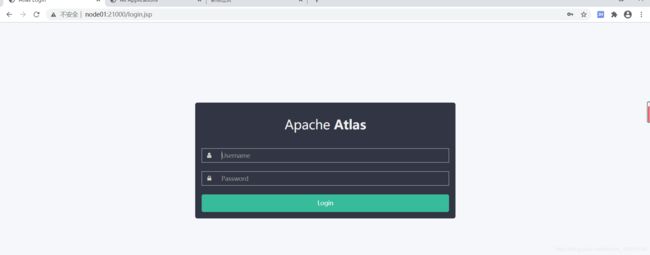apache Atlas 1.2.0 搭建以及hive的集成
apache Atlas 1.2.0 搭建以及hive的集成
简介
ps:(官网摘抄)
Atlas 是一组可扩展且可扩展的核心基础治理服务,使企业能够高效、高效地满足 Hadoop 内的合规性要求,并允许与整个企业数据生态系统集成。
为组织提供开放的元数据管理和治理功能,以构建其数据资产目录,对这些资产进行分类和治理,并为数据科学家、分析师和数据治理团队提供围绕这些数据资产的协作功能。
特点:
- 元数据类型和实例
- 各种 Hadoop 和非 Hadoop 元数据的预定义类型
- 能够为要管理的元数据定义新类型
- 类型可以具有基元属性、复杂属性、对象引用;可以从其他类型的继承
类型(称为实体)的实例捕获元数据对象详细信息及其关系 - 使用类型和实例的 REST API 允许更轻松地集成
分类:
- 能够动态创建分类 - 如 PII、EXPIRES_ON、DATA_QUALITY、敏感
分类可以包括属性 - 如expiry_date分类EXPIRES_ON属性 - 实体可以与多个分类关联,从而更轻松地发现和安全实施
- 通过血统传播分类 - 自动确保分类在经过各种处理时遵循数据
血统:
- 直观的 UI,用于查看数据在各种程序流程中的数据走向和来源
- 通过 REST AP来访问和更新血统
- 搜索/发现
直观的 UI 按类型、分类、属性值或自由文本搜索实体
要按复杂条件搜索的丰富的 REST API
SQL 类似于搜索实体的查询语言 - 特定于域的语言 (DSL)
atlas主要借助了hbase用来存储数据信息
通过solr存储相关的所以,由此提供了丰富的restful API 提供我们进行索引库的查询
各类元数据之间的关系atlas借助了图数据库janusGraph

1.下载源码
Apache Download Mirrors
选择镜像进行下载
下载后上传到你的linux环境下进行解压
tar -zxvf apache-atlas-1.2.0-sources.tar.gz
就可以得到atlas的源码目录
接下来需要编译
准备编译的环境
java1.8
maven3.5以上
node.js(构建的时候涉及到需要npm进行下载,自行配置好)
构建编译过程可以参考官网
2.编译源码
进入atlas源代码目录中用maven编译源文件
mvn clean -DskipTests package -Pdist,embedded-hbase-solr
编译过程比较长,因为还要下载hbase+solr
编译结束后可以看到源码目录下
/export/servers/apache-atlas-sources-1.2.0/distro/target
多了这些包,其中主要通过apache-atlas-1.2.0-server 进行配置启动
3.修改配置
在编译之后我们需要改一下配置文件atlas-application.properties
atlas.graph.storage.backend=hbase
atlas.graph.storage.hbase.table=apache_atlas_janus
atlas.graph.storage.hostname=localhost
atlas.graph.storage.hbase.regions-per-server=1
atlas.graph.storage.lock.wait-time=10000
atlas.EntityAuditRepository.impl=org.apache.atlas.repository.audit.HBaseBasedAuditRepository
atlas.graph.index.search.backend=solr
atlas.graph.index.search.solr.mode=cloud
atlas.graph.index.search.solr.zookeeper-url=localhost:2181
atlas.graph.index.search.solr.zookeeper-connect-timeout=60000
atlas.graph.index.search.solr.zookeeper-session-timeout=60000
atlas.graph.index.search.solr.wait-searcher=true
atlas.graph.index.search.max-result-set-size=150
######### Notification Configs #########
atlas.notification.embedded=true
atlas.kafka.data=${sys:atlas.home}/data/kafka
atlas.kafka.zookeeper.connect=localhost:9026
atlas.kafka.bootstrap.servers=localhost:9027
atlas.kafka.zookeeper.session.timeout.ms=400
atlas.kafka.zookeeper.connection.timeout.ms=200
atlas.kafka.zookeeper.sync.time.ms=20
atlas.kafka.auto.commit.interval.ms=1000
atlas.kafka.hook.group.id=atlas
atlas.kafka.enable.auto.commit=false
atlas.kafka.auto.offset.reset=earliest
atlas.kafka.session.timeout.ms=30000
atlas.kafka.offsets.topic.replication.factor=1
atlas.kafka.poll.timeout.ms=1000
atlas.notification.create.topics=true
atlas.notification.replicas=1
atlas.notification.topics=ATLAS_HOOK,ATLAS_ENTITIES
atlas.notification.log.failed.messages=true
atlas.notification.consumer.retry.interval=500
atlas.notification.hook.retry.interval=1000
atlas.server.http.port=21000
atlas.enableTLS=false
atlas.authentication.method.kerberos=false
atlas.authentication.method.file=true
#### ldap.type= LDAP or AD
atlas.authentication.method.ldap.type=none
#### user credentials file
atlas.authentication.method.file.filename=${sys:atlas.home}/conf/users-credentials.properties
atlas.rest.address=http://localhost:21000
# If enabled and set to true, this will run setup steps when the server starts
#atlas.server.run.setup.on.start=false
######### Entity Audit Configs #########
atlas.audit.hbase.tablename=apache_atlas_entity_audit
atlas.audit.zookeeper.session.timeout.ms=1000
atlas.audit.hbase.zookeeper.quorum=localhost:2181
######### High Availability Configuration ########
atlas.server.ha.enabled=false
atlas.authorizer.impl=simple
atlas.authorizer.simple.authz.policy.file=atlas-simple-authz-policy.json
atlas.rest-csrf.enabled=true
atlas.rest-csrf.browser-useragents-regex=^Mozilla.*,^Opera.*,^Chrome.*
atlas.rest-csrf.methods-to-ignore=GET,OPTIONS,HEAD,TRACE
atlas.rest-csrf.custom-header=X-XSRF-HEADER
atlas.metric.query.cache.ttlInSecs=900
######### Gremlin Search Configuration #########
#Set to false to disable gremlin search.
atlas.search.gremlin.enable=false
########## Add http headers ###########
#atlas.headers.Access-Control-Allow-Origin=*
#atlas.headers.Access-Control-Allow-Methods=GET,OPTIONS,HEAD,PUT,POST
#atlas.headers.=
根据自己的需求可以在这里进行配置,
可以参考官网,由于这里我选择本地测试用,所以hbase,solr我都是选择的localhost默认本地,如果有自己搭了集群的可以修改配置切换成集群环境
4.启动
在本地模式下的solr不需要自己创建节点,atlas的启动脚本中
/export/servers/apache-atlas-sources-1.2.0/distro/target/apache-atlas-1.2.0-server/apache-atlas-1.2.0/bin/atlas_start.py
已经默认帮我们创建了
进入bin目录启动atlas
访问webui界面
http://node01:21000/
输入初始化账号密码admin/admin
进入
查看solr界面http://192.168.100.210:9838/
起初是没有数据的,可以通过bin目录下的
![]()
进行测试数据的导入
5.集成hive
这里以hive为例,在工作中,如果没有特定的元数据管理平台进行管理,你很难去维护你数仓中各个表之间的关系,以及每个表是否被引用
借助atlas平台可以有效的监控hive任务以及他们的血统关系,让你的数据拒绝成为数据孤岛和数据沼泽
换句话说,以大数据开发为基础的数据中台,如果缺少了一个元数据管理平台,那么它是不完整的
目前的环境,目前我部署了三台机器作为自己的测试集群,在hive启动正常的前提下
atlas是如何集成hive的呢,他会利用hook作为钩子,监听你的hive 事件,消息数据发送到指定的kafka队列中
以此来构建各个实体之间的关系
所以要集成hive需要改两个配置
hive-site.xml
hive-env.sh
进入/export/servers/apache-hive-2.1.1-bin/conf 目录
添加一下配置到hive-site.xml
<property>
<name>hive.exec.post.hooksname>
<value>org.apache.atlas.hive.hook.HiveHookvalue>
property>
添加一下配置到hive-env.sh
export HIVE_AUX_JARS_PATH=/export/servers/apache-atlas-sources-1.2.0/distro/target/apache-atlas-1.2.0-server/apache-atlas-1.2.0/hook/hive
如果你是配置多台机器的集群的话,需要在每台机器的hive上都存在有/export/servers/apache-atlas-sources-1.2.0/distro/target/apache-atlas-1.2.0-server/apache-atlas-1.2.0/hook/hive
这个目录所以我们采用scp 将文件分发到我们的机器上
进入/export/servers/apache-atlas-sources-1.2.0/distro/target/apache-atlas-1.2.0-server/apache-atlas-1.2.0/hook/
scp -r hive root@node02:/export/servers/apache-atlas-sources-1.2.0/distro/target/apache-atlas-1.2.0-server/apache-atlas-1.2.0/hook/
scp -r hive root@node03:/export/servers/apache-atlas-sources-1.2.0/distro/target/apache-atlas-1.2.0-server/apache-atlas-1.2.0/hook/
然后对应的hive配置修改也要到各自的机器上进行修改
集成过程中可能会因为缺少某个jackson的包导致失败
jackson-jaxrs-json-provider
jackson-jaxrs-base
jackson-module-jaxb-annotations
2.9.9版本
可以手动下载对应版本的jackson包放到
shell/export/servers/apache-atlas-sources-1.2.0/distro/target/apache-atlas-1.2.0-server/apache-atlas-1.2.0/hook/hive/atlas-hive-plugin-impl/
在进行分发
然后重启hive,确定能否正常重启
查看我们当前的数据库是否有数据,因为atlas它只能监听当前的操作,所以我们需要将历史的数据进行导入
然后在重启atlas
重启后要检查对应的solr和hbase有没有正常启动可以通过jps检查当前的java进程是否存在这两个应用,因为hbase是主要的存储数据库,如果没启动的话,是检索不到我们的元数据的
进行hive历史数据的导入
进入/export/servers/apache-atlas-sources-1.2.0/distro/target/apache-atlas-1.2.0-server/apache-atlas-1.2.0/hook-bin/
执行import-hive.sh脚本
需要输入默认的账户和密码
导入成功后我们查看ui界面可以看到对应的数据了
此时可看到我们的数据了,可以根据自己的需求给表添加分类,元素等信息
然后我们试着新建表并插入数据,查看能否监听到我们的操作
-- 创建表
create table t_host_event (ip string , event string);
-- 插入数据
insert into t_host_event values ('192.168.100.210','login on hive');
-- 关联查询操作
select * from t_host_info left join t_host_event on t_host_info.ip=t_host_event.ip;
-- 关联查询操作写入新表
create table t_host_info2event as select host,t_host_info.ip ,event from t_host_info left join t_host_event on t_host_info.ip=t_host_event.ip
监控了我们对hive的操作,以及构建了我们的结果表的生成逻辑血缘图
这将很好的帮助我们定位到每一张表的链路实现


















